WW2 in the Far East
Battle for Hong Kong  Click here!
Click here!
CPO Hong Kong final days December 1941  Click here!
Click here!
 Singapore, Malaya and India Click Here
Singapore, Malaya and India Click Here
RAPC POWs 1941-1945  Click here!
Click here!
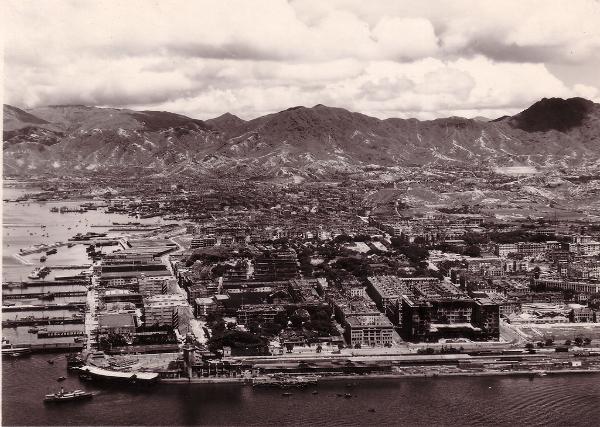
Kowloon, 1945 - Photo by Bill Lake
In December 1941 the Army Pay Services of Hong Kong consisted of the Command Pay Office, Command Paymaster Colonel N. Forde, RA PC, five officers, 28 other rank and eight Chinese clerks, to which was attached on mobilisation the Pay Section of the HKVDC (Hong Kong Volunteer Defence Corps), OC Maj C. de S. Robertson, three officers and 14 other ranks.
The Canadian Force Field Cashier was Captain R M Davies, RCAPC, who was killed in action. His office was in close proximity to the Command Pay Office, but worked quite independently . The two Indian Army accountants were to join the Command Pay Office with their staffs at the outbreak of hostilities, but were prevented. from doing so by difficulties of transport and communications. One of these two accountants. was killed in action.
2nd Echelon was attached to the Office and remained with it throughout the operations . Captain E. Lewis, a Hong Kong business man was commissioned as officer-in-charge, and he lived with the RAPC officers until his admission to hospital, where he died in 1944.
The Battle for Hong Kong December 8 to 25, 1941
Following his appointment as Commander-in-Chief of the British Far East Command, Air Chief Marshal Sir Robert Brooke-Popham requested reinforcements for Hong Kong as he believed even a marginal increase in the garrison could significantly slow down the Japanese in case of war. Though not believing that the colony could be held indefinitely, a protracted defense would buy time for the British elsewhere in the Pacific.
Final Preparations:
In 1941, Prime Minister Winston Churchill agreed to dispatch reinforcements to the Far East. In doing so, he accepted an offer from Canada to send two battalions and a brigade headquarters to Hong Kong. Dubbed "C Force," the Canadians arrived in September 1941, though they lacked some of their heavy equipment. Joining Major General Christopher Maltby's garrison, the Canadians prepared for battle as relations with Japan began to falter. Having taken the area around Canton in 1938, Japanese forces were well positioned for an invasion. Preparations for the attack began that fall with troops moving into position.
The Battle of Hong Kong Begins:
Around 8:00 AM on December 8, Japanese forces under Lieutenant General Takashi Sakai began their attack on Hong Kong. Commencing less than eight hours after the attack on Pearl Harbor, the Japanese quickly gained air superiority over Hong Kong when they destroyed the garrison's few aircraft. Badly outnumbered, Maltby elected not to defend the Sham Chun River line at the colony's border and instead deployed three battalions to the Gin Drinkers Line. Lacking sufficient men to fully man the line's defenses, the defenders were driven back on December 10 when the Japanese overran the Shing Mun Redoubt.
Retreat to Defeat:
The rapid breakthrough surprised Sakai as his planners had anticipating needing a month to penetrate the British defenses. Falling back, Maltby began evacuating his troops from Kowloon to Hong Kong Island on December 11. Destroying harbor and military facilities as they departed, the final Commonwealth troops left the mainland on December 13. For the defense of Hong Kong Island, Maltby re-organized his men into Eastern and Western Brigades. On December 13, Sakai demanded that the British surrender. This was promptly refused and two days later the Japanese began shelling the island's northern shore.
Another surrender demand was rejected on December 17. The next day, Sakai began landing troops on the island's northeastern coast near Tai Koo. Pushing back the defenders, they were later guilty of killing prisoners of war Sai Wan Battery and Salesian Mission. Driving west and south, the Japanese met heavy resistance over the next two days. On December 20 they succeeded in reaching the south coast of the island effectively splitting the defenders in two. While part of Maltby's command continued the fight on the western part of the island, the remainder was hemmed in on the Stanley Peninsula.
On Christmas morning, Japanese forces captured the British field hospital at St. Stephen's College where they tortured and killed several prisoners. Later that day with his lines collapsing and lacking critical resources, Maltby advised Governor Sir Mark Aitchison Young that the colony should be surrendered. Having held out for seventeen days, Aitchison approached the Japanese and formally surrendered at the Peninsula Hotel Hong Kong.
Command Pay Office Hong Kong final days December 1941
It was at breakfast time on 8th December 1941 that the Command Paymaster in Hong Kong, Colonel N. Forde, was informed of the outbreak of war with Japan. Only 11 days previously he had been joined by Major (later Brigadier) R. D. Buck as his Assistant Command Paymaster. On 2nd December they had inspected the accommodation which had been earmarked for occupation in the event of attack. It consisted of a number of houses and flats some 1,500 ft above sea level in the Peak area. The buildings were situated round the lip of a small hollow. They seemed suitable in size and layout and were reasonably remote from possible enemy interference. The Canadian Army Pay Office was located in the vicinity of No 9 the Peak, which was to be the premises of the Command Pay Office.
Enemy action began with an air attack against Kai Tak airport. At nine o'clock on 8th December the detachment assembled at HQ Hong Kong Command. By nightfall the Command Pay Office had completed its move to the Peak, except for the Regimental Services Section. It had been a laborious business due to the long climb for the heavily Iaden vehicles, but there had been no enemy interference although the harbour was being bombed. Three days later the Office was working in its new location. There was, however, a major snag. In the adjacent hollow was a battery of six-inch howitzers. Before the move of the Office there had been an assurance that the Gunners would not occupy this site, but, in fact, the Office was less than 100 yds in front of the line of howitzers. Each round fired shook the building.
Meantime the Cashier, in a requisitioned car, had visited units in all parts of the island. Then, at 1100 hours, a round from one of the howitzers struck the corner of the Officers' Mess. Soon afterwards the Gunners informed the Command Paymaster that the building would have to be demolished. It was in the line of fire. The position became completely untenable when a battery of 3.7 inch howitzers took up an adjacent position and the six inch battery began to fire directly over the Office as the enemy advanced. It was decided to move to Mount Austin Barracks some four minutes walk away.
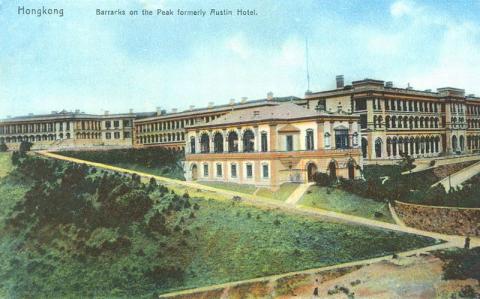
Mount Austin Barracks
The next day the former Office was hit by Japanese gunfire and one of the 3.7 howitzers was knocked out. With extraordinary calmness office work continued in the NAAFI building. AFs N 3085 were opened by the Adrema system.
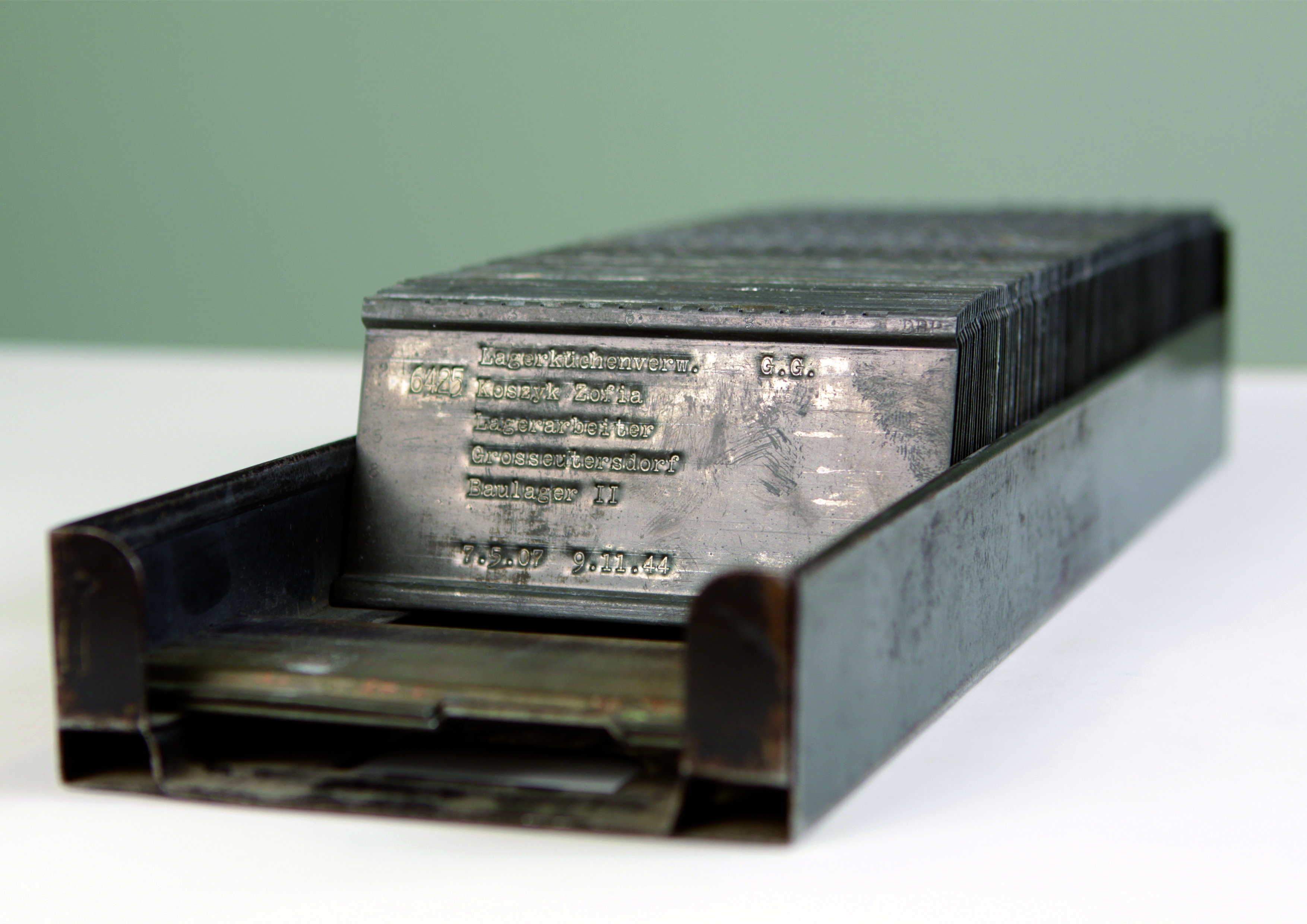
Adrema Plates
(ed:
Adrema plates were 10 by 4 cm thin metallic plates on which addresses or other information could be "pressed". After that the plates were used as printing plates. Especially during the second World War, the system ADREMA [which stands for Adressenmachine, Address Machine] was used by many German companies for registering the forced labourers.)
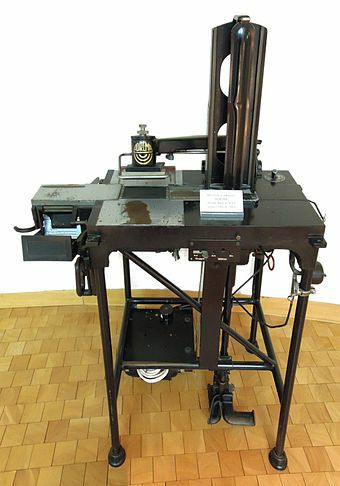
Adrema Machine
The steadiness of the Corps personnel was matched by the Chinese staff, in particular the Cashier's Clerk and the Adrema Operator. Roads became cratered, Magazine Gap being under direct observation by the enemy. Drawing rations was a hazardous business, but readily undertaken by Sgt I. F. Lyle and Cpl W. G. Lamb.
It was reported that signals from houses on the Peak were being made to the enemy on the mainland. Sgt D. H. Clark and some of the detachment investigated. A Japanese lady was brought in, but she was blameless. In all probability it was reflected light from windows set swinging by shellfire. As a Lewis Gun Anti-Aircraft post was being established in the main entrance to the officers' quarters the staff went about office duties. The run-off of Adrema plates was completed on the l7th. This was the last day for "normal" work.
The bombardment of the barracks continued with mounting damage. A round entered the West end of the building and struck the Adrema machine. The Command Paymaster ordered the evacuation of the building used as quarters by the soldiers when another round went through the roof. About half past seven in the evening the electricity failed and was never restored. The power station was in Japanese hands. All day on the l9th the Detachment, in relays, fought a fire in the small arms ammunition store. It was thought that the Gunners might have left some of their six-inch ammunition in a magazine underneath the store, but heat made inspection impossible.
During the day the Cashier visited units in various parts of the Island despite the damage to roads. On the 20th the office on the Peak occupied by the Canadians received a direct hit. The Field Cashier, Captain R M Davies, was killed on the spot and the senior Administrative Officer Colonel Hennessey, died while being taken to the main dressing station. Captain Davies was buried in the vicinity.
The next day, with reports about the proximity of Japanese troops increasing, the Command Paymaster and the Cashier went to the bank and withdrew the holding of sterling. As they left the city there was heavy mortar fire from the Kowloon area. The sterling was destroyed by fire later in the day. The Chinese clerks were sent home to their families as the shelling grew more intense. This was the last that was seen of the Chinese staff, who had remained loyal and conscientious to the end. Corps personnel were now concentrated in a ground floor passage.
The position in Mount Austin Barracks was untenable. Consequently, on 22
nd December, yet another move was made to four small flats which were sheltered from the mainland by the summit of Mount Kellett. There was now very little water, although some was collected in the baths of the flats. A swimming bath in the garden of a Chinese mansion was allocated as a water point, but was soon destroyed by shell fire. Amazingly some technical work was still being carried on including Part II Orders, acquittance rolls, returns, correspondence and cash transactions. When, on the 24th, there was a direct hit on the premises, permission was secured for yet another move, to Hong Kong University. Personnel wended their way on foot along roads pitted with shell holes and strewn with the burning wrecks of vehicles. The office records were taken by truck, but it was not possible to recommence office work. On the other hand there was water and the RASC Supply Depot was in the University.
On Christmas Day a search was still going on in the city for more suitable office accommodation and the Banque de I'Indo-Chine was looked at. It was all to no avail. At 1600 hours news was received that the Island had been surrendered.
Aftermath of the Battle of Hong Kong:
Subsequently known as "Black Christmas," the surrender of Hong Kong cost the British around 9,500 captured as well as 2,113 killed/missing and 2,300 wounded during the battle. Japanese casualties in the fighting numbered 1,996 killed and around 6,000 wounded. Taking possession of the colony, the Japanese would occupy Hong Kong for the remainder of the war. During this time, the Japanese occupiers terrorized the local population. In the wake of the victory at Hong Kong, Japanese forces embarked on string of victories in Southeast Asia which culminated with the capture of Singapore on February 15, 1942.
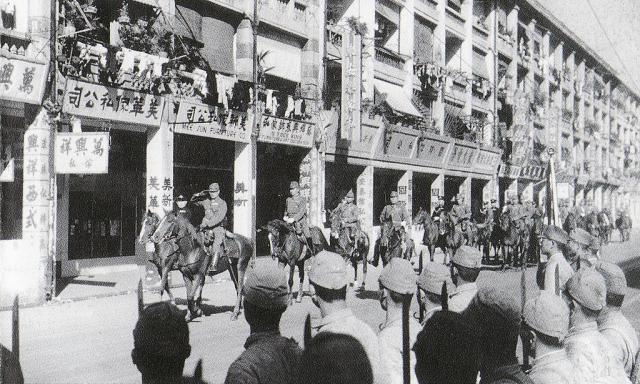
Lt. Gen. Sakai formally enters Hong Kong
[Top]
Royal Army Pay Corps (RAPC) Captured in Hong Kong December 1941
6 Officers 28 Men interned in Hong Kong or Transported to Japan
Forde, Noel Colonel Commanding interned Formosa
Backhurst, Keith Keel Private 7673629 Died 16.8.42 (Septicaemia)
Buck, Robert Digby Major (14)
Carden, William T. Staff Sergeant 2320254 (Third Transportation) (
POW ID Tag)
Chalcraft, Harry Lance Sergeant 840233 (Third Transportation)
Compton, Wilfred George Private 7678254 (Third Transportation)
Cox, Brian Corporal 6201464 (Fifth Transportation)
Eady, Frederick Thomas Private 7675954 Bowen Road Hospital Died 6.1.44
Earnshaw, Charles Eric Private 7677853 Interned Formosa
Evans, Thomas David F. Private 7679700 (argyle) (Fifth Transportation)
Gower, Alan Theodore Staff Sergeant 1671350 (Third Transportation)
Hemming, Clarence P. G. Corporal 853998 (Fifth Transportation)
Hold, Ambrose Alvey Corporal 7673575
Howard, Robert W.H. L/Captain
Ingleby, William H. Corporal 556333 (Fifth Transportation)
James, Joseph Leslie Staff Sergeant 7260223
Luckhurst, Henry Herbert Lance Sergeant 825116 (First Transportation)
Awarded MM 1946
Lyle, Ian Fargie Lance Sergeant 3058417 (Fifth Transportation)
Murray, Alan Everest Lance Sergeant 826879
Died 2002
Muttock, James Harry Corporal 7887428 (Fifth Transportation)
Norrell, Friend William SQMS 6335458
Osborne, Dudley E. A/SSM 7658043
Pendergast, Maurice Corporal 1873616 (Fifth Transportation)
Pinkey, William T. Staff Sergeant 6197916 (Fifth Transportation)
Reed, John Fortington Sergeant 550782
Roberts, John Richard Lance Sergeant 7884537 (First Transportation)
Simpson, Norman M. Staff Sergeant 403731 (Fifth Transportation)
Smart, Jack Corporal 7885633 St. Teresa’s Hospital Died 13.2.42 Dysentery
Stevenson, Andrew Private 7670798 (Fifth Transportation)
Stone, Earnest D. Corporal 812098
Taylor, George Edward Lieutenant
Thompson, Thomas A. L/Captain MBE
RAPC Sources show the following RAPC personnel were also captured and subsequently repatriated:
Maj J. R. Burne
Maj C. J. H. Treglown, MC
Lt G. H. Brett
Lt C. A. Buckmaster
Lt C. H. Farmer
Lt R. J. McCullough
Lt D. B. H. Scott
Lt C. G. Sturt, MBE
WO1 G . H. Barlow
W02 G. W. Bellars
W02 E. Owen
SSgt C. A. Fraser
Sgt H. Chapman
Sgt J. H. Craven
Sgt F. C. Hillyard
Sgt C. H. Lane
Sgt A. G. Matthews
Sgt A. Mclntosh
Sgt G. A. Pow
Sgt P . J . Stack
Sgt A. E. Starkey
Sgt C. S. Topliss
Sgt D. A. White
LSgt H. H. Trotter
Cpl E. F. Humphries
Pte D. Pethebridge
Pte J. C. Watson
Identity tag, Far-East POW© IWM (EPH 87)
|

Identity tag issued to Major W T Carden whilst a POW in Shamshuipo camp, Hong Kong and Nagasaki and Omine camps in Japan where he worked in the mines. Prior to capture he had been an NCO in the Royal Army Pay Corps. The number ‘176’ indicates the camp number (‘Haku Nanaju Roku’) and the symbol below signifies that he was also a camp fireman. He kept a graphic diary during his captivity, which he hid in a hole in the ground used by prisoners as a toilet.
‘Deaths very frequent although no one takes much notice these days’,
(Diary entry by Bill Carden while in Shamshuipo camp in 1942)
|
Shamshuipo Camp
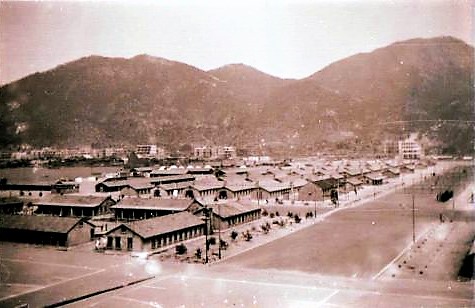
[Top]
Hong Kong RAPC POW's Lament (from the Corps Magazine 1946)
|
On Christmas Day in '41
Our troubles were just begun
For on that day at 3 p.m.
We fell to the "Rising Sun".
They took us first to "Wellington"
Sappers and Gunners too
Right next door to the Ordnance Store
I leave the rest to you.
Then on we go to "Murray"
Where lo! what do we see
The lads in Blue, the Navy
And heavens the D.D.C.
Then early one bright morning
We packed our kits to go
To Canton? Maybe further
No one seemed to know.
First we stopped in Statue Square
Where we partook of lunch
Then over on the ferry
All huddled in a bunch.
Our route is then by Argyle Street,
But they won't let us stay
So on we go on aching feet
To Sham Shuipo by Lai Chi Bay.
A place at last to rest awhile
But when we look around
There's not a door or window pane
Whatever to be found.
|
But that of course was '41
And now its '45
And things look somewhat different now
To them thats still alive.
The Engineers have found some glass
If chance you have a fag
And gardens bloom most anywhere
We have not time to lag.
And so we have some fun and games
And music with P.T.
They tell us now it won't be long
Ah, well, we'll have to see.
And now we've seen The "Sun" has set
And once again we're free.
No more for us the rice and veg
With now and then some tea.
We've had our spot of "Repat" leave
With double rations too
And back we are in "harness"
With stacks of work to do.
With Slipping and Releases
And A.B. 64s
Controls and lots of filing
The time that's left is yours.
They tell us there is "twenty eight"
For every "Regular" man
But that of course is "wait and see"
We'll get it if we can.
|
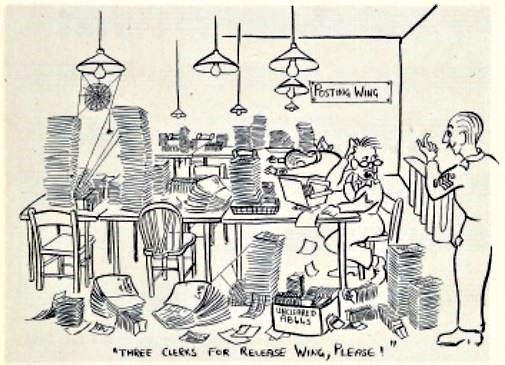
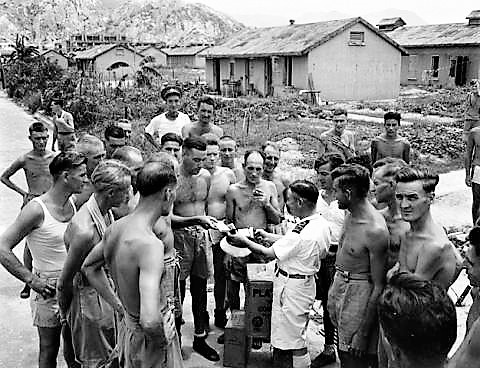
Shamshuipo Camp Liberation 1945
Military Medal Award for the defence of Hong Kong in 1941
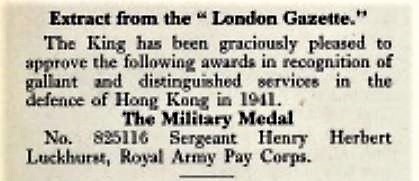
[Top]